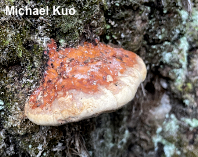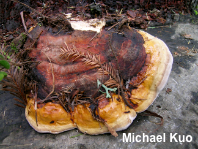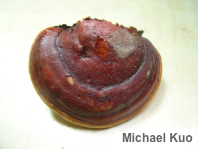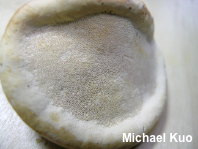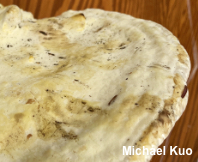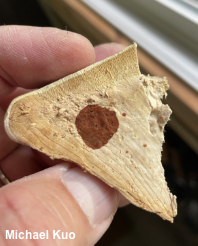| Major Groups > Polypores > Fomitopsis mounceae |

|
Fomitopsis mounceae [ Basidiomycota > Polyporales > Fomitopsidaceae > Fomitopsis . . . ] by Michael Kuo What happens when a North American conifer falls in the woods and no one is there to hear it? This well-known fungus, along with its close relatives, gets ready for dinner! According to Gilbertson and Ryvarden (1986), it is "one of the most conspicuous and widely distributed polypores in coniferous forest regions of the northern hemisphere. It is a major factor in the production of brown rot residues that are a stable soil component in coniferous forest ecosystems." Distinguishing features for Fomitopsis mounceae include the varnished-looking red to orange band that is almost always present on the cap surface (varying in width, depending on how old the mushroom is), the whitish to faintly yellowish pore surface, the whitish flesh, and the usually strong, pungent odor. A drop of KOH on the flesh produces a red to reddish brown reaction. While Fomitopsis mounceae is primarily associated with conifer wood, it is also sometimes found on the deadwood of hardwoods. These "distinguishing" features actually apply to two other species, as well: Eurasia's Fomitopsis pinicola, and western North America's Fomitopsis schrenkii. The former does not occur in North America, and the latter appears on the Great Plains and the southern Rocky Mountains—more or less in a zone from South Dakota to San Diego and New Mexico. Since the range of Fomitopsis mounceae is mostly more northern, from about the 40th parallel northward (imagine a line from the District of Columbia to the Bay Area in northern California), there is only a little overlap between it and Fomitopsis schrenkii; in these areas it may not be possible to separate the two species without reference to DNA. Fomitopsis ochracea is somewhat similar in appearance, but lacks red colors on the cap surface. Varnished-looking, red species of Ganoderma can appear superficially similar, but feature brownish flesh that turns black with KOH, as well as very different microscopic features. Fomitopsis mounceae and Fomitopsis schrenkii are treated as "Fomitopsis pinicola" in most North American sources, but recent studies by Haight and collaborators (2016, 2019) have split up this species group. Description: Ecology: Saprobic on the deadwood of conifers and hardwoods; also sometimes parasitic on living trees; causing a brown cubical rot; growing alone or gregariously; perennial; originally described from Alberta, Canada; widespread in North America from roughly the 40th parallel northward. The illustrated and described collections are from California, Michigan, and Pennsylvania. Cap: 7–24 cm across and 6–17 cm deep; more or less semicircular in outline; convex or, over the years, becoming hoof-shaped; with orange to red, varnished zones of color toward the margin (and overall when young); red to dark brownish red or gray-brown toward the point of attachment when mature; with a fairly thick white to pale yellowish marginal zone; varnished areas bubbling and melting with flame. Pore Surface: Whitish to slightly yellowish; not bruising significantly—or, when older, bruising slowly yellowish to brownish; appearing "stuffed" when young; with 3–5 round pores per mm; annual tube layers usually fairly distinct, up to 1 cm deep. Stem: Absent. Flesh: Creamy; unchanging when sliced; faintly zoned; leathery to woody. Odor: Strong and fragrant when fresh. Chemical Reactions: KOH on cap, flesh, and pore surface red to brownish red. Microscopic Features: Spores 6–7 x 3.5–4.5 µm; subellipsoid; smooth; hyaline in KOH; inamyloid. Basidia 4-sterigmate. Cystidia sometimes present; 20–40 x 4–5 µm; sublageniform to fusiform; smooth; thin-walled; hyaline in KOH. Hyphal system trimitic, with thin-walled generative hyphae, thick-walled skeletal hyphae, and branching, thick-walled binding hyphae. REFERENCES: J. -E. Haight & K. Nakasone, 2019. (Overholts, 1953; Smith, Smith & Weber, 1981; Arora, 1986; Gilbertson & Ryvarden, 1986; Phillips, 1991/2005; Lincoff, 1992; Roody, 2003; McNeil, 2006; Miller & Miller, 2006; Trudell & Ammirati, 2009; Kuo & Methven, 2014; Desjardin, Wood & Stevens, 2015; Haight et al., 2016; Siegel & Schwarz, 2015; Baroni, 2017; Sturgeon, 2018; Haight et al., 2019; McKnight et al., 2012.) Herb. Kuo 01140601, 09182101, 05212201. This site contains no information about the edibility or toxicity of mushrooms. |
© MushroomExpert.Com |
|
Cite this page as: Kuo, M. (2022, June). Fomitopsis mounceae. Retrieved from the MushroomExpert.Com Web site: http://www.mushroomexpert.com/fomitopsis_mounceae.html |

